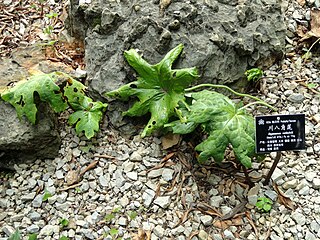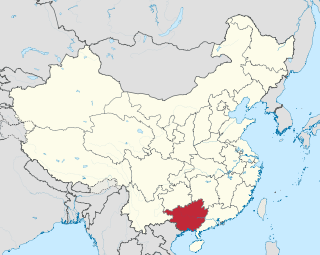This page is based on this
Wikipedia article Text is available under the
CC BY-SA 4.0 license; additional terms may apply.
Images, videos and audio are available under their respective licenses.
Taiping, Tai-p’ing, or Tai Ping usually refers to:

The Xiang River is the chief river of the Lake Dongting drainage system of the middle Yangtze, the largest river in Hunan Province, China. It is the 2nd largest tributary in terms of surface runoff, the 5th largest tributary by drainage area of the Yangtze tributaries. The river flows generally northeast through Guangxi and Hunan two provinces, its tributaries reach into Jiangxi and Guangdong.

Beihai is a prefecture-level city in the south of Guangxi, People's Republic of China. The name of the city means "north of the sea" in Chinese, signifying its status as a seaport on the north shore of the Gulf of Tonkin, which has granted it historical importance as a port of international trade for Guangxi, Hunan, Hubei, Sichuan, Guizhou, and Yunnan. Between the years 2006 and 2020, Beihai is predicted to be the world's fastest growing city. Beihai has a large shipyard, but most of the money generated in the city is derived from trade.
Hepu is a county in Guangxi, China.
Sanhe may also refer to these places in China:

Triadica is a plant genus of the family Euphorbiaceae first described as a genus in 1790. It is native to eastern southeastern, and southern Asia.
- Triadica cochinchinensis Lour. - China, Cambodia, Assam, Bangladesh, Bhutan, Nepal, Himalayas of E + N India, Borneo, Sulawesi, Sumatra, Laos, Malaysia, Myanmar, Philippines, Thailand, Vietnam
- Triadica rotundifolia (Hemsl.) Esser - Guangdong
- Triadica sebifera (L.) Small - China, Japan; naturalized in Himalayas, Cuba, Puerto Rico, SE + SC USA, Sacramento Valley in N California
Changping or Chang Ping, may refer to:
Xihe is the atonal pinyin romanization of the Mandarin pronunciation of various Chinese names.
Baisha may refer to these places:

China National Highway 207 (G207) runs from Xilinhot, Inner Mongolia to Hai'an, Guangdong. It is 3,738 km (2,323 mi) in length and runs south from Xilinhot through Inner Mongolia, Hebei, Shanxi, Henan, Hubei, Guangxi, and ends in Guangdong.
Chengbei (城北区) is a district of Xining, Qinghai, People's Republic of China (PRC).

Dysosma is a group of herbaceous perennials in the Berberidaceae or barberry family described as a genus in 1928. It is native to China and Indochina.
The Luoyang–Zhanjiang railway or Luozhan railway, is a major rail corridor in China between Luoyang, Henan Province on the Yellow River in the Central Plain, and Zhanjiang, Guangdong Province on the South China Sea. The rail corridor runs through four provinces and one autonomous region—Henan, Hubei, Hunan, Guangxi and Guangdong—and is designed to facilitate the shipment of goods from the Chinese interior to the Port of Zhanjiang. The rail corridor was proposed in 1999 and is a combination of preexisting railways and new railway sections built for the Luozhan railway. The new railway sections fill a gap in the railway network of South Central China between the Beijing-Guangzhou and Jiaozuo–Liuzhou railways. In eastern Guangxi, the Luozhan railway forks at the town of Cenxi and follows two routes to Zhanjiang. The Luoyang–Zhanjiang Rail corridor's total length has been reported as 1,991 km (1,237 mi) to 2,063.9 km (1,282 mi).
Nanping (南平) is a prefecture-level city in Fujian, China.

Guangxi ( ; formerly romanised as Kwangsi; Chinese: 广西; Zhuang: Gvangjsih, officially the Guangxi Zhuang Autonomous Region, is an autonomous region of the People's Republic of China, located in south China and bordering Vietnam. Formerly a province, Guangxi became an autonomous region in 1958.








